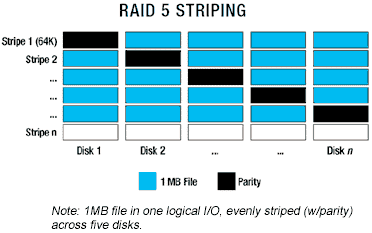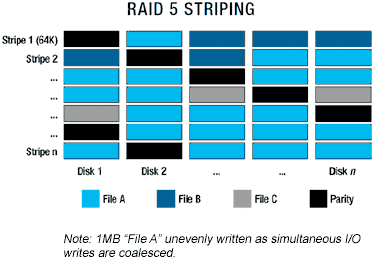RAID Arrays
CPU and memory performance has increased geometrically while storage performance has lagged behind. RAID arrays have improved to help reduce this gap but can suffer from slow performance due to excessive I/O. Slow RAID array performance can bottleneck a whole system slowing your applications.
The Windows OS inherently splits files apart and scatters them around a volume instead of writing them in one place contiguously. When this happens a large number of unnecessary requests are sent to the RAID controller.
This is where DymaxIO I/O optimization software comes in—by proactively preventing unnecessary I/O at the Windows OS level. Preventing unnecessary I/O not only prevents the degradation in VM and application performance but improves RAID array performance, keeping it running at peak speeds.
Get IDC’s Technology Spotlight: How to Manage the I/O Explosion with No Additional Hardware »

The solution to Increasing RAID Array Performance
A file system generates a lot of unnecessary I/Os, however, the RAID controller is unaware that the multiple I/Os are part of the same file and treats each I/O as a separate entity. This leads to RAID array performance degradation. Preventing excessive and unnecessary I/O at the file system level and consolidating data into a single I/O improves the performance of write and read activities.
DymaxIO I/O optimization software uniquely addresses the unnecessary I/O patterns of reads and writes by aggregating data on writes to perform sequentially while caching reads on available server memory without contention to the application.
As a result, DymaxIO boosts application performance by 50% or more by
(1) maximizing the efficiency of every single I/O from write requests that leave the server and
(2) caching the most active data from read requests using available server memory

Read I/O Optimization – Much of the I/O traffic moving through the infrastructure shares similar data, yet every byte of that data travels the entire distance from server to storage and back for every I/O request, even when it is frequently accessed data. IntelliMemory™ technology addresses this read request inefficiency by caching the most active data in the server’s available memory. Should an application require more memory, DymaxIO serves memory back to the application to ensure there is never a case of memory starvation or resource contention. Condusiv Technologies’ self-learning caching algorithms have set the gold standard for the industry as they are OEM’d by eight of the top ten largest PC manufacturers in the world.
Write I/O Optimization – DymaxIO IntelliWrite® technology optimizes I/O write operations, eliminating the performance penalties associated with the Windows OS, splitting files into pieces and writing each piece to a different logical location within the SAN or NAS. V-locity is aware of space allocation and aggregates write to behave sequentially—requiring less I/O for every file written. Subsequent reads also benefit, since the only minimum, I/O is required to fulfill the request. As a result, only productive I/O requests are processed across the entire infrastructure, enabling more data to be processed in the same amount of time.
When only productive I/O traffic is processed through the server, network and storage, I/Os per second are accelerated, latency is greatly reduced, and more work can be performed in the same amount of time. This greatly improves the efficiency of all VMware ESX/ESXi and Microsoft Hyper-V virtual platforms and physical servers for increased bandwidth.
DymaxIO I/O optimization is tailored for virtual environments that leverage a SAN or NAS as it proactively provides I/O benefit—improving storage performance and benefiting advanced storage features like snapshots, replication, data deduplication, and thin provisioning. Since DymaxIO optimizes I/O at the server level, it is complementary to all SAN and NAS storage systems and media types (e.g., HDD or SSD).
Download a trial of DymaxIO and put it to the test in your real-world environment »
Find The Right Solution For Your Server Performance Challenge
We provide solutions for over 90% of fortune 500 companies and are dedicated to finding the right solution to remedy your Windows Server performance challenge too. Select your area of concern below.
What People are Saying
What People are Saying
“Typically, IT professionals respond to application performance issues by reactively buying more hardware. Without the luxury of a padded budget, we needed to find a way to improve performance on the hardware infrastructure we already have. It saved us from having to make a heavy investment in SSDs or do a complete rip and replace of our entire hardware infrastructure. To this day, I still can’t believe software is doing this.”
R. Ortiz, IT Manager, ASL Marketing
“I have used Diskeeper since it was first introduced. It has always worked well in keeping my drive defragged for the fastest response times for all of my apps. Thank you again for this fine piece of software.”
Philip Baldwin, NVQB
“The Undelete software that we use on all our Regional Servers is undoubtedly worth every penny. It
has saved our Techs numerous hours in restoring files inadvertently deleted as opposed to having to
restore from backup tape.”
Michael Lucas, Gancom (Division of Gannet Fleming)
“Undelete saves backup restores when someone accidentally deletes a file from a Windows share. We store tapes off site so Undelete can save a big delay for file restores of that type. Undelete does what it says on the box – really – and it works nicely as a network recycle bin.”
Glenn Edwards, Infrastructure Analyst, Itron
“I have been using Diskeeper for many years, it is installed as a routine on all servers, networked clients, SHO and any other computer. It has never presented any problem and has always demonstrated improved drive performance in both servers and clients. With each new release Condusiv does not merely provide “window dressing”, they actually improve the product with the objective of making it easier to use, more reliable, more effective and easier to use.”
Mark Sills, Systems Administrator / Manager, Home User

